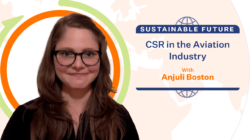Leadership with Passion through Kokorozashi
The key ingredient to success? Passion.
Finding your kokorozashi will unify your passions and skills to create positive change in society. This GLOBIS Unlimited course will help you develop the values and lifelong goals you need to become a strong, passion-driven leader.
Let’s face it: the current economic model of human civilization is not sustainable. And the reason is waste.
In a linear economy (the economic model we currently have), we’re stuck on a one-way road leading to ever-increasing amounts of waste: plastic, chemicals, metals, and other materials. These aren’t things the earth can reuse in its natural systems, so we’re stuck waiting for them to simply disappear over (a long, long) time.
A circular economy may be the solution to creating a two-way street. Robin Lewis, cofounder of sustainability-focused startup mymizu, explains what the circular economy is, how it differs from a linear economy, and what lies beyond.
Next Article
The Circular Economy, Your Business, and Your Future
3 Lessons from mymizu for Launching Your Social Enterprise
Transcript
The Difference between a Linear Economy and a Circular Economy
Robin Lewis:
A circular economy is an economic system which is the opposite of the linear economy in which we take, then make we waste. And it’s generally characterized by three elements:
- One is the elimination of waste and pollution
- Two is the circularity of products and materials
- Three is regeneration of nature.
So what’s really interesting about a circular economy is it’s essentially a system without waste. And waste is a human concept.
When you look at natural systems, there is actually no waste. So if you consume a banana, the peel will go into the soil, which will feed the insects that will go back into the air, and so on. There’s all kinds of circular systems in our everyday, in our natural environments.
Waste occurs when humans take the resource is from the earth (like oil), we create something (let’s say a petroleum-based product like plastic), and then we waste it. We burn it when we finished using it. That is not a circular economy. That is a linear economy. And so if you look at nature, it actually has a lot of solutions. And those are the kinds of things that we can tap into and adapt for our economic model.
How to Realize Circular Economic Change
Lewis:
Ultimately, the responsibility to shift to a circular economy lies with every single one of us because all of us, no matter whether we’re a business, an individual, or a government, we require things like clean water, things like breathable air. And so unless we can guarantee those things for today and for the years to come, then there is no economic activity. There is no continuation of our current societal structure. So ultimately it is all down to every single one of us.
The first step to moving a company to a circular model is to really get a grasp of where you are in terms of your social or environmental impact. Every company has some kind of impact. And unless we really analyze and understand where we are, it’s really hard to find those areas of improvement and make those changes. So my first piece of advice would be to really understand where your business is in terms of social and environmental impact.
Leadership with Passion through Kokorozashi
The key ingredient to success? Passion.
Finding your kokorozashi will unify your passions and skills to create positive change in society. This GLOBIS Unlimited course will help you develop the values and lifelong goals you need to become a strong, passion-driven leader.
The Future of Our Economy: Beyond the Circular Economic Model
Lewis:
Honestly, I think moving to a circular economy is one step, but there is now more conversation around nature-positive and regenerative economies. And this is kind of the next level.
I see a circular economy as going from a minus to a zero. So we’re not generating waste. We’re living in a very efficient economy. But if we’re actually talking about creating positive value for the environment and our society, then we can even take further steps.
So I think the question is, “Do we want to just create a circular economy? Or do we wanna go beyond that to the next level?”




